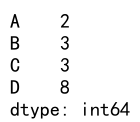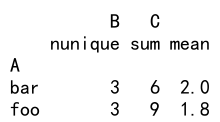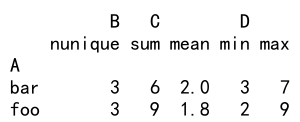Pandas中使用agg和nunique函数的详细指南
Pandas是一个强大的Python数据分析库,它提供了许多用于数据处理和分析的功能。在本文中,我们将详细介绍如何使用Pandas的agg和nunique函数来进行数据聚合和统计唯一值的数量。这些功能在数据分析中非常有用,尤其是在处理大型数据集时,了解数据的多样性和汇总信息是非常重要的。
1. 理解nunique函数
nunique函数用于计算数据中唯一值的数量。这在统计每个类别或组中不同元素的数量时非常有用。
示例代码 1:基本使用nunique
import pandas as pd
data = {
'A': ['foo', 'bar', 'foo', 'bar', 'foo', 'bar', 'foo', 'foo'],
'B': ['one', 'one', 'two', 'three', 'two', 'two', 'one', 'three'],
'C': [1, 2, 3, 1, 2, 3, 1, 2],
'D': [2, 3, 4, 5, 6, 7, 8, 9]
}
df = pd.DataFrame(data)
result = df.nunique()
print(result)
Output:

2. 理解agg函数
agg函数(也称为aggregate函数)用于对数据进行聚合操作,它可以接受一个或多个操作来应用于数据集上。
示例代码 2:使用agg进行基本聚合
import pandas as pd
data = {
'A': ['foo', 'bar', 'foo', 'bar', 'foo', 'bar', 'foo', 'foo'],
'B': ['one', 'one', 'two', 'three', 'two', 'two', 'one', 'three'],
'C': [1, 2, 3, 1, 2, 3, 1, 2],
'D': [2, 3, 4, 5, 6, 7, 8, 9]
}
df = pd.DataFrame(data)
result = df.agg(['sum', 'min'])
print(result)
Output:

3. 结合使用agg和nunique
结合使用agg和nunique可以在同一操作中计算多种统计数据,包括唯一值的数量。
示例代码 3:结合使用agg和nunique
import pandas as pd
data = {
'A': ['foo', 'bar', 'foo', 'bar', 'foo', 'bar', 'foo', 'foo'],
'B': ['one', 'one', 'two', 'three', 'two', 'two', 'one', 'three'],
'C': [1, 2, 3, 1, 2, 3, 1, 2],
'D': [2, 3, 4, 5, 6, 7, 8, 9]
}
df = pd.DataFrame(data)
result = df.agg({'A': 'nunique', 'B': 'nunique'})
print(result)
Output:

4. 使用agg和nunique处理更复杂的数据结构
在处理更复杂的数据结构时,如分组数据(grouped data),agg和nunique的组合尤其有用。
示例代码 4:在分组数据上使用agg和nunique
import pandas as pd
data = {
'A': ['foo', 'bar', 'foo', 'bar', 'foo', 'bar', 'foo', 'foo'],
'B': ['one', 'one', 'two', 'three', 'two', 'two', 'one', 'three'],
'C': [1, 2, 3, 1, 2, 3, 1, 2],
'D': [2, 3, 4, 5, 6, 7, 8, 9]
}
df = pd.DataFrame(data)
grouped = df.groupby('A')
result = grouped.agg({'B': 'nunique', 'C': ['sum', 'mean']})
print(result)
Output:

5. 高级应用:自定义聚合函数
在某些情况下,内置的聚合函数可能无法满足需求,此时可以定义自定义聚合函数。
示例代码 5:使用自定义聚合函数
import pandas as pd
data = {
'A': ['foo', 'bar', 'foo', 'bar', 'foo', 'bar', 'foo', 'foo'],
'B': ['one', 'one', 'two', 'three', 'two', 'two', 'one', 'three'],
'C': [1, 2, 3, 1, 2, 3, 1, 2],
'D': [2, 3, 4, 5, 6, 7, 8, 9]
}
df = pd.DataFrame(data)
def custom_agg(x):
return x.max() - x.min()
result = df.agg({'C': custom_agg, 'D': custom_agg})
print(result)
Output:

6. 性能考虑
在使用agg和nunique进行大规模数据处理时,性能是一个重要考虑因素。优化聚合操作可以显著提高效率。
示例代码 6:优化聚合操作
import pandas as pd
data = {
'A': ['foo', 'bar', 'foo', 'bar', 'foo', 'bar', 'foo', 'foo'],
'B': ['one', 'one', 'two', 'three', 'two', 'two', 'one', 'three'],
'C': [1, 2, 3, 1, 2, 3, 1, 2],
'D': [2, 3, 4, 5, 6, 7, 8, 9]
}
df = pd.DataFrame(data)
result = df.groupby('A').agg({'B': 'nunique', 'C': ['sum', 'mean'], 'D': ['min', 'max']})
print(result)
Output:

7. 结论
在本文中,我们详细介绍了如何使用Pandas的agg和nunique函数进行数据聚合和计算唯一值的数量。通过多个示例代码,我们展示了这些函数在不同场景下的应用,包括基本聚合操作、处理分组数据、使用自定义聚合函数以及性能优化。
 极客教程
极客教程